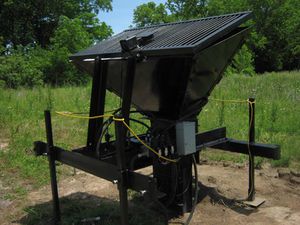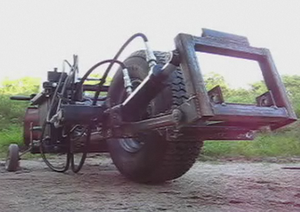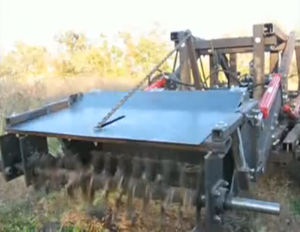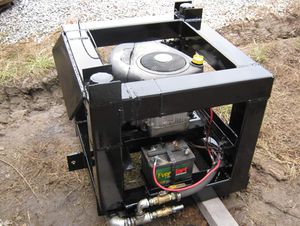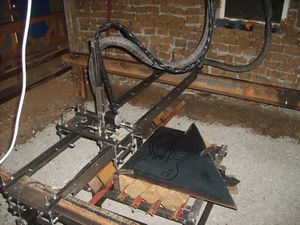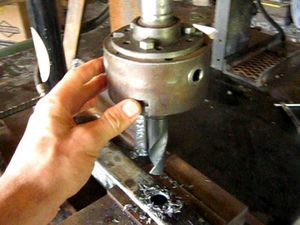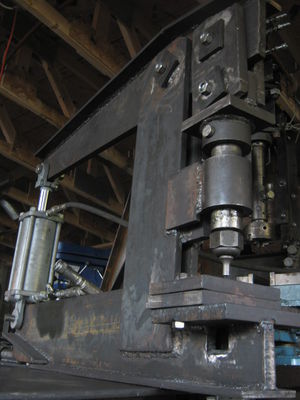Crash course on OSE/uk
| Crash Course This is a Crash Course on Open Source Ecology (OSE). In the next 15 minutes, you will be brought up to date on all the work of OSE from the last 4 years. Email crashcoursemoderator at gmail dot com for support. See also Technical Abstract of the GVCS. |
Загальний огляд
Для того щоб побачити чим ми займаємось, перегляньте відео GVCS за 2 хвилини. Open Source Ecology була заснована в 2004 Марцином Якубовским. Ми мережа фермерів, інженерів та помічників, які останні два роки створювали Global Village Construction Set, вільну, недорогу, високоефективну технологічну платформу, що дозволяє нам самим створювати 50 різних індустріальних машин, які необхідні для створення стійкої цивілізації з сучасними зручностями. GVCS знижує бар'єри на шляху вступу в сільське господарство, будівництво, виробництво і може розглядатися як набір Lego, в натуральну величину, модульних інструментів, які можуть створювати цілі економіки, чи то в сільських районах Міссурі (де проект був заснований), в міській реконструкції або в самому серці Африки.
We have an ambitious program for product release of the 49 remaining technologies within 2 years and a $2.4M budget - which we abbreviate as our 50/2/2 program. The period for this is 2011-2012.
Основні характеристики GVCS
These are the Key Features of the GVCS, and if you want to see the full set of values, see Core Values of OSE.
Ключові особливості
|
Scope of the GVCS
Scope
|
Current Status
last updated: 25. April 2011.
The following prototypes and products are developed until now:
| The Compressed Earth Brick (CEB) Press allows for rapid (16 brick per minute), low-cost, high-quality construction from on-site earth. The CEB Press is used to compress clayey soil (20-30% clay by volume) from local or on-site soils into structural masonry (700-1000 PSI) building blocks. Stabilization with cement may be used for additional weather resistance. CEB also lends itself to the construction of floors, paved areas, retaining walls, storage structures, or any other structures where a uniform, structural building block is desired.
Links: The Liberator, The CEB Story, initial field testing, pressing bricks, disassembly, crating (packaging), machine overview, the frame, the controller, CEB Machine Controller: Fabrication Recursion, Complete CEB Walkthrough. Documentation: Introduction, Build Instructions, CAD Files | |
| LifeTrac is a versatile, 4-wheel drive, full-sized, hydraulically-driven, skid-steering tractor of 18-200 hp with optional steel tracks. LifeTrac is intended to be a minimalist but high-performance, lifetime design, design-for-disassembly workhorse and power unit of any land stewardship operation. It features easy serviceability by the user. Its modular nature allows for quick attachment of implements; interchangeability/stackability of multiple power units (Power Cubes) for adapting power level to the task at hand; quick attachment of all hydraulic components via quick-coupling hoses; including quick interchangeability of hydraulic motors for use in other applications.
Links: Stage I of Development, Prototype II Completed, moving. Documentation: Build (wiki page with videos), Blender Files; Quick Attach Plate and Tracks CAD | |
| MicroTrac is a scaled-down, walk-behind version of the the full-sized LifeTrac to address the need for a microtractor. We are using most of the same components as LifeTrac, except we are shrinking the structural members – to retain part interchangeability between MicroTrac and LifeTrac.
Links: Prototype I completed blog post, prototype I completed video, zero turn, Microtrac Prototype II, Prototype II Challenge. Documentation: wiki documentation ; Prototype I Blender File | |
| The Soil Pulverizer can be attached to LifeTrac and pulverizes the soil to a fine consistency which can be used in preparation for pressing Compressed Earth Bricks (CEBs).
Links: blog, construction and test (short video), test (video). | |
| The Power Cube II is an universal, self-contained power unit that consists of an engine coupled to a hydraulic pump for providing power to different devices in the form of hydraulic fluid at high pressure. The Power Cube is a module that can be attached to the LifeTrac, Microtrac, Bulldozer, and Open Source Car (OSCar) platforms. It connects to other devices via quick couplers and quick-connect hydraulic hoses.
Links: short and long (50min) video. Documentation: Blender Files. | |
| CNC Torch Table is a cutting table. A computer can control the torch head making clean sharp cuts on XYZ axes. Prototype I has been built, but has not been operated successfully because the radiation emitted by the plasma cutter that was used with the table caused electronics failure. We will finish Prototype I by retrofitting it with open source stepper motor controllers.
Links: wiki page, Plasma cutter in action, Open Source Torch Table Part 4, Part 5, Part 6. Documentation: Build (wiki), Blender File; Prototype I First Fire | |
| The Drill Press is for drilling 1″ and larger holes directly in metal without pre-drilling. It contains a hydraulic motor for the drilling and a hydraulic cylinder for the down pressure – so this is a literal press, and it is not short on torque or power as the motor can sustain up to 20 hp. We are using our Universal Rotor for the motor.
Links: video Documentation: documentation | |
| The Ironworker Machine is a device that can instantly cut steel and punch holes in metal thicknesses of 1". Currently the 150 Ton Hole Puncher is prototyped.
Links: 150 Ton Hole Puncher's blog post Documentation: Hole Puncher's Wiki Docu, Wiki Category |
Open Source Ecology won the MAKE Green Project Contest.
Our new website is online - http://opensourceecology.org
In March 2011, Marcin gave his TED Talk. Since then, the project is getting a lot of attention.
Future Plans
Proposal 2012 contains all the updated information about the vision of the GVCS. The goal is to gather $2.4M of support to complete the GVCS in 2 years (the end of 2012).
GVCS components expected in 2011 are:
- Power Cube III – 55 HP (Horse Power)
- CNC Torch Table I
- LifeTrac III
- Soil Pulverizer III
- Modern Steam Engine I – Our goal is on the order of $500 in materials cost for a 1 kW generator, with favorable cost scaling for higher power. Introduction and more videos are available here: 1 kW Steam Engine Electric Generator Prototype
- Ironworker machine II
- Aluminum extraction from clay
If funding and collaborators are found, other parallel developments are possible.
Currently, there are 4 tractors, 4 CEB presses, 8 Power Cubes, and 2 Soil Pulverizers to be built till the end of Mai. The CNC Torch Table is in completion process to help with that.
Construction business using the Tractor-Soil Pulverizer-Compressed Eearth Brick (CEB) Press package will start in Los Angeles by an early adopter, Joskua Designs. This will be the first field testing outside of Factor E Farm. The building project in California will have to deal with earthquake codes.
We are looking for active collaboration in all projects.
Completion of the modular CEB workshop is planned in June.
We will also do prototype CEB/straw housing units with the assistance from our new Polish friends to build out as needed to accommodate other developers at Factor e Farm.
We'll be holding our first major Factor e Farm Convergence (Kansas City Area) on September 1-30 at Factor e Farm, to make major strides on the ground with respect to the Global Vilage Construction Set (GVCS) development.
Distributed power generation is a clear goal – the next major field of endeavor for Factor e Farm, which would allow us to fuel our operation for free – from agriculture, off-grid fabrication workshop, to living and transportation.
After the GVCS completion the first OSE Community will be built and Education and Training in 2-year immersion program are planned.
After winning the MAKE Green Project Contest we will participate in the 2011 Maker Faire where LifeTrac will be shown.
We are participating in the Buckminster Fuller Challenge 2011, an annual international design Challenge awarding $100,000 to support the development and implementation of a strategy that has significant potential to solve humanity’s most pressing problems.
Adam Shilling, a True Fan, is planning a multiplayer online game based on the GVCS as the inspiration for its connection to the real world. Adam is going to South America to meet real people – to assess the needs of real communities. The project will link gaming to the real world – where money exchanged ends up purchasing things like tractors or renewable energy equipment for villages in South America.
A Documentary Film about Factory E Farm may come in the future.
Support OSE and collaborate with us to help us make this happen.
Our current needs are listed in the Project needs.
Getting Involved
| Get yourself involved! If you liked what you've seen, please check the Get involved page to see the various ways you can contribute your time and skills to our project |
If you want to join quickly some of the project, then check the Guide to OSE Projects.
Media and Interviews
For Interviews, please check our Press Procedure. Here you can find High Resolution GVCS Media.
Keywords
Required Reading for Developers
- OSE Specifications
- Proposal 2012
- GVCS Development Template
- Product Template
- Development Team
- Wiki Policy
- Forum Policy
Other
- Conferences
- Media Development
FAQs
To Do Items
See GVCS Tasks and Project needs.
